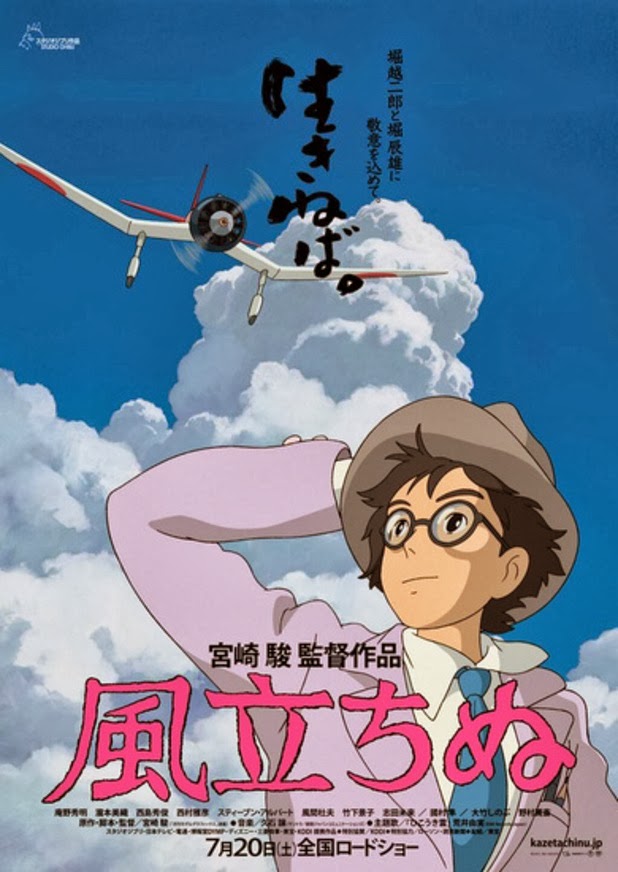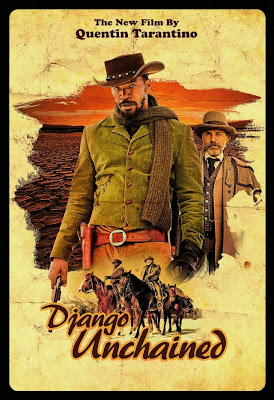Jiro Dreams Of Fighter Planes: ‘The Wind Rises’ (Movie Review)
The Wind Rises:
4 ½ out of 5
Hayao
Miyazaki: I get inspiration from my everyday life.
The
Wind Rises is a wonderful addition to Studio Ghibli’s
impressive library of anime features.
With only a hint of fantastical elements, which mainly come in the form
of dream sequences, The Wind Rises is
really an animated biopic of a man responsible for designing Japanese fighter
planes during WWII, but with a fictionalized focus on his personal life. There are numerous themes that the film
attempts to explore, but even while it has a sense of melancholy to go with the
main character’s own sense of discovery, it stays back from the messy politics
of it all. Really, this is a story of a
man who had dreams of creating an ideal design and how he balanced his goals
with the reality of life.
This is reportedly the
final film from acclaimed Japanese director Hayao Miyazaki, who has been largely responsible for creating many
wonderful and memorable anime films released through Studio Ghibli, including Princess Mononoke and the Oscar-winning Spirited Away. If The Wind
Rises is in fact the last film directed by Miyazaki, then he certainly
chose an interesting and somewhat fitting story, as it focuses on an introverted
character who dreams big. While the
ultimate conclusion of this film is far different than anything Miyazaki has
experienced, there is a connection I saw between the director and the film’s
protagonist that added an interesting level of focus to how I absorbed the
film.
The
Wind Rises feels largely restrained and I mean that in a good
way. I mentioned earlier how the film is
free of the fantastical elements that are common in Miyazaki’s other
films. Because of that, The Wind Rises has a much more apparent
feel of a character study. Not to say
that characters in other Miyazaki films are not rich and interesting, but The Wind Rises is one focusing almost
solely on the various people involved in this story, due to the fact that the
visuals, while arresting, are not as visually dynamic in an effort to really
inform the narrative as much as the players involved do. With that in mind, the tone of this film has
more of a mellow feel. It actually is
somewhat similar to other Miyazaki films in that respect, but it then comes
down to how the film exists in a grounded reality that sets it apart.
We follow Jiro
Horikoshi, who is an unassuming man, but clearly someone with plenty of ideas
and aspirations. The film details his
journey to becoming a key player in designing Japanese aircraft, which will
later be used during significant events in World War II history, but the film
has more going on than just this story.
Really, Jiro’s job merely provides historical context, but the lead
character and his work could be switched to something else, yet still have the
same story be told. It would take away
some of the impact, but the path is still clear, as the romantic element is a
large part of this story as well.
Jiro’s relationship
with Naoko, whom he initially meets during his travel to Tokyo and involves an
impactful event, provides the film with another aspect that fits with the
initial narrative, but also allows Jiro to open up as a character. The
Wind Rises certainly allows for happiness in the lives of its characters,
but there is inevitability there as well, which goes on to highlight the themes
of this film. One could reason that this
is why the film cannot simply replace its lead, as the history involved in this
story actually is important, but along with this film being a heavily
fictionalized version of Jiro’s actual life, it is more or less a film that
relies on familiar dramatic plot devices, which happen to fit within the
context of the period chosen.
Getting away from the
more melancholy aspects of this film though, The Wind Rises is a film that had me thoroughly engaged throughout. Yes, the animation is designed to have a
grounded feel, as there are only some dream sequences that make up the more ‘out-there’
moments, but the look of engines, various planes (also trains and automobiles),
and even a sequence depicting an earthquake, all allow for the film to really
engage the viewer with interesting details surrounding settings and equipment
that are unlike anything they could perhaps see in reality. I was never going to question a Miyazaki
film, when it came to the visual aesthetic, but he certainly showed me
something new in The Wind Rises,
which is amusing, given that it was something so real for a change.
In addition to the
visuals, sound and music have always been wonderful aspects to admire and The Wind Rises is a great auditory
experience. The sound design on the
engines, in particular, has a great and distinctive feel that lends the film an
identity. The score by frequent Miyazaki
collaborator, Joe Hisaishi, is incredibly fitting and elegant in its
presentation within the film. To address
the vocal performances, I had the chance to see this film in its original
Japanese language, so I cannot attest to the quality of the English dub, but I
have never had much of a problem with how the English versions of these films
are handled and the talent involved in the dub (which includes Joseph Gordon-Levitt,
Emily Blunt, Stanley Tucci, and William H. Macy, among others) is pretty solid.
Ponyo
was Miyazaki’s previous directorial effort and I really enjoyed that film,
which really was ‘out there’ in terms of the fantastical elements involved. The
Wind Rises is decidedly different, very focused, very grounded, and
character-based. Regardless of whether
it is animated or not, the core story is interesting and quite emotional. The fact that it is an anime feature only
lends the film to a superb and unique visual presentation for this story, which
I was quite fond of. The film may have a
tone that is not as bright and sunny as other animated fare, but it does have a
good story to tell from a man who has held onto a reputation of being a master
storyteller, with plenty of imagination on his mind to share as well. If The
Wind Rises is in fact Miyazaki’s final feature, I can only hope more like
him have just as much imagination to share, in order to keep the legacy of
Studio Ghibli alive.
Hayao
Miyazaki: My
process is thinking, thinking and thinking - thinking about my stories for a
long time.
Aaron is a writer/reviewer for WhySoBlu.com. Follow him on Twitter @AaronsPS4.
He also co-hosts a podcast, Out Now with Aaron and Abe, available via iTunes or at HHWLOD.com














Comments
Post a Comment